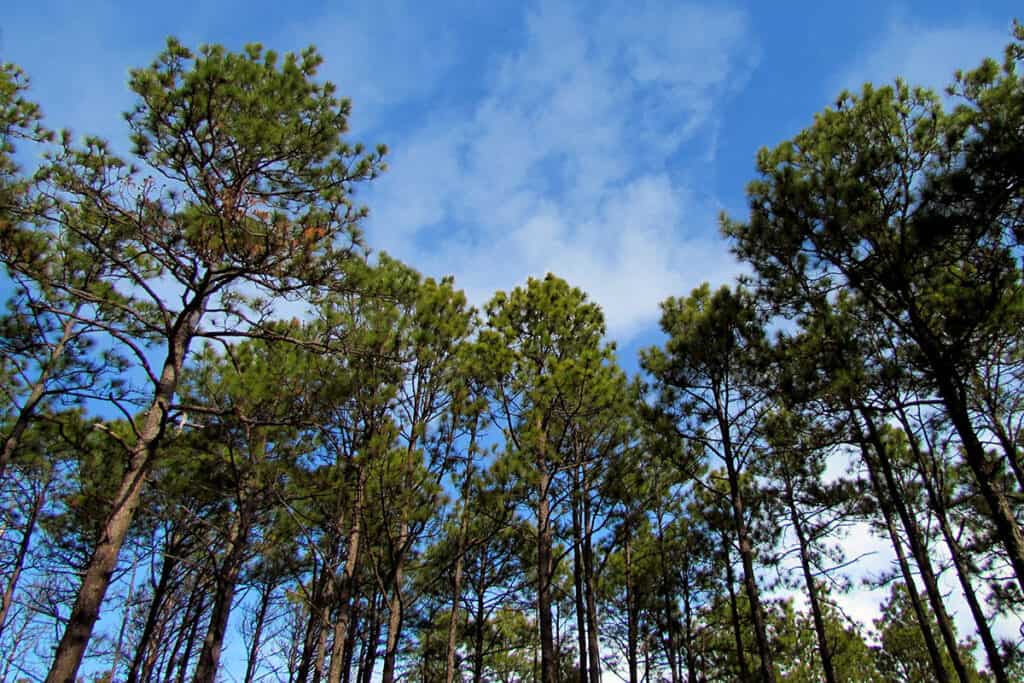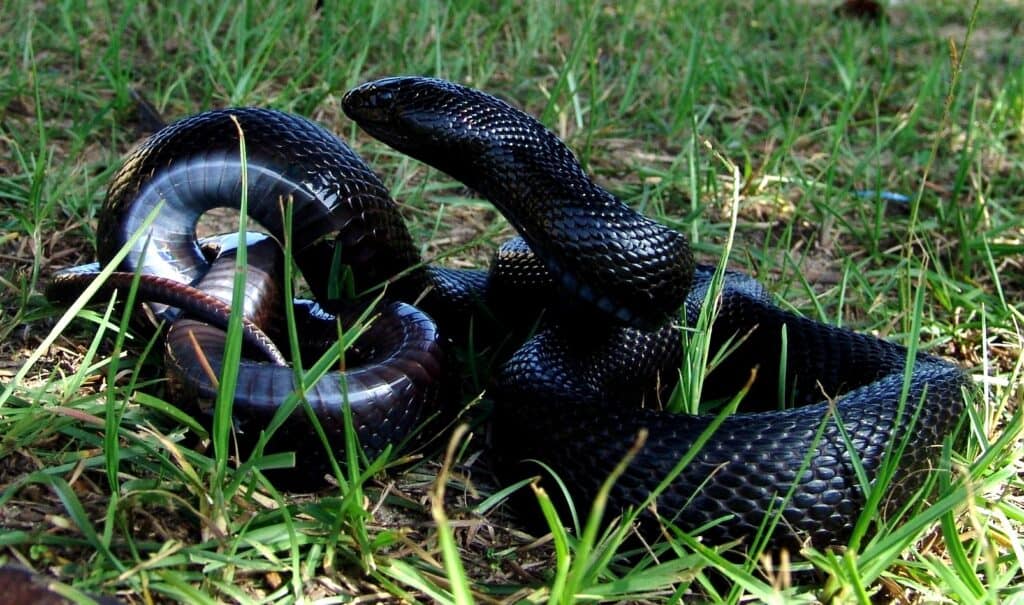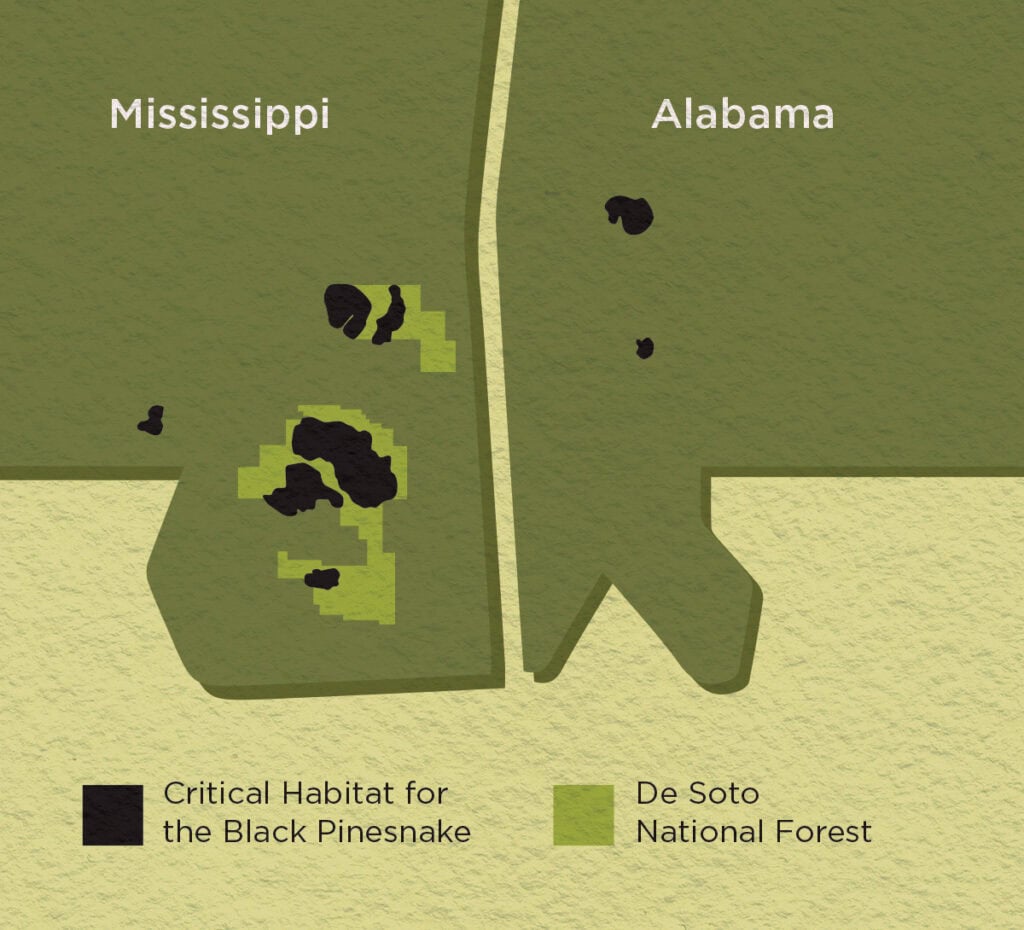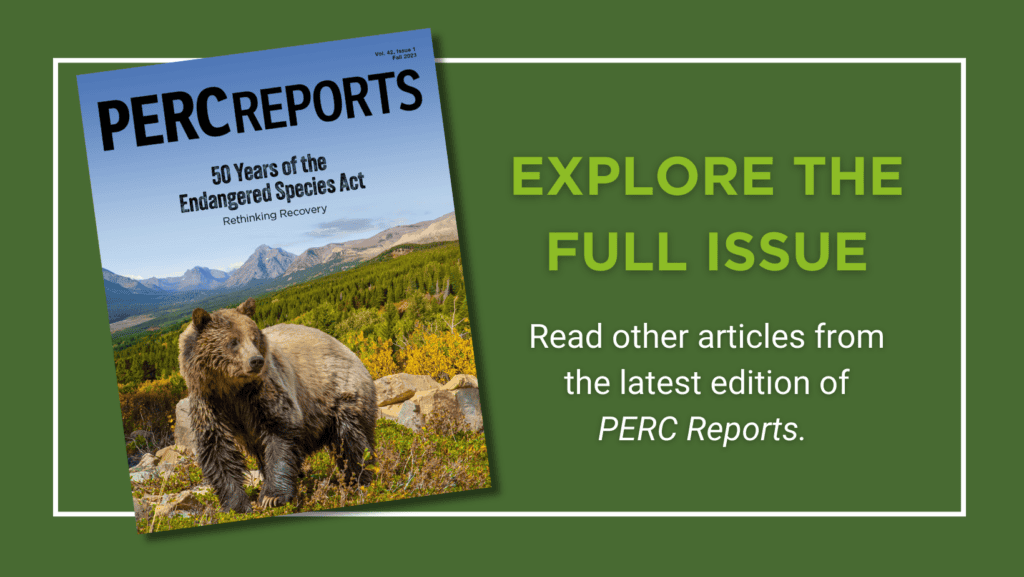
This special issue of PERC Reports examines the Endangered Species Act with an eye toward improving the incentives for species recovery. Read the full issue.
Gray Skipper knows exactly where to find a black pinesnake, and it’s not on his family’s timberland in southwestern Alabama. “Your best chances,” Skipper says, “are outside the Mobile airport in a pecan orchard. You’re more likely to see one there than if you sit here for five years looking for one.” Skipper has never seen one in the wild, on his land or otherwise. In fact, the only one he’s seen was at the Bass Pro Shops store in Jackson, Mississippi. “The Fish and Wildlife Service had brought one there,” he says.
Federal officials took a black pine snake to an outdoors shop because, not long before then, the government had proposed designating more than 300,000 acres of critical habitat for the species in Mississippi and Alabama, a designation that would affect private lands covered by it. In 2015, the Fish and Wildlife Service listed the snake as threatened under the Endangered Species Act. Much of the proposed designation encompassed Desoto National Forest, in Mississippi, where the most reliable sightings of black pinesnakes have been documented. But the agency also circled 90,000 acres of private land in the region, including about 30,000 acres that belong to Skipper’s family in Clarke County, Alabama.
Skipper’s family has stewarded large swaths of timberland since the early 20th century. For much of that time, they opened tens of thousands of acres to public hunters through a lease with the state of Alabama. That access also permitted the state to carry out various wildlife surveys and studies, work that furthered research and conservation efforts that the family was proud of. Little did they expect that it would eventually open a door to federal regulation. “No good deed goes unpunished,” Skipper now says.
What’s the point of regulating private property with critical habitat designations if they breed acrimony with the very people who could provide essential habitat for a rare frog, snake, or any other at-risk species?
The landowners are now suing the Fish and Wildlife Service, arguing that the agency used insufficient scientific evidence in making its designation and did not properly consider its economic burdens. The designation of Skipper’s land is based on five sightings of black pinesnakes between 1990 and 2015. According to the agency, that means the land is occupied by the reptile.
Skipper and his attorney Charles Yates, of Pacific Legal Foundation, contend that the record is flimsy. “Four isolated observations of black pinesnakes from almost 30 years ago,” Yates says in describing them, “and one black pinesnake caught in a turkey trap in 2015. That’s it, yet somehow that meets the definition of occupied.” For Skipper’s part, he says that if his land is so ideal for the reptile, then where are all the pinesnakes?
The conflict echoes a similar case involving another federally protected species, the dusky gopher frog, which was decided by the U.S. Supreme Court in 2018. The ruling led the Fish and Wildlife Service to remove a tract of private land in Louisiana from its critical habitat designation for the frog, ultimately a win for the landowners. But the case underscored the crucial question about critical habitat and private land: What’s the point of regulating private property with critical habitat designations if they breed acrimony with the very people who could provide essential habitat for a rare frog, snake, or any other at-risk species?
As with the dusky gopher frog, the implications of the black pine snake case will extend far beyond the timberlands of the Deep South. They will reverberate for private landowners nationwide, who provide habitat for approximately two-thirds of federally listed species. And the incentives landowners face have a direct effect on the recovery prospects for rare species. “Infringing property rights is no way to encourage conservation,” as Yates puts it. “For more than half a century, the Skippers have responsibly managed their land. Now the service is penalizing them for it.”
A Legacy of Conservation
Relatively few black pine snakes remain in the wild. Population estimates are hard to come by given that the reptiles spend most of their time underground, often in rotted-out root systems of longleaf pine trees. The snake, actually one of three subspecies of pine snake, is confined to about a dozen counties in Mississippi and Alabama, according to the Fish and Wildlife Service, including the roughly 30,000 acres of private land in Clarke County owned by Skipper and relatives.
Skipper is vice president of Scotch Plywood and a fourth-generation member of a group of families who have stewarded forestland since 1902. In 1956, the family enrolled their land in a long-term WMA lease with the state. “Timber was our main focus,” Skipper says, “and taking care of the land takes care of the timber, and it also takes care of the wildlife.” While the family saw the lease mainly as a way for members of the public to hunt for a modest fee, it also advanced state wildlife research at a time when deer and turkey populations were flagging. “So us being part of the WMA,” he says, “was to provide a place for anybody to be able to afford to go hunting, and to help learn with the state biologists.”

Skipper said he first learned about his family’s land being included in the designation when it was published in the Federal Register. “They didn’t give anybody a heads up—not even a phone call,” he says. The original proposal noted that the land was included based on four sightings of black pine snakes that date back to 1990, the sightings that attorney Yates describes as “isolated.” After that first proposal, a black pine snake sighting was documented on the property thanks to the Skippers’ long-standing collaboration with Alabama biologists. “The state had a turkey hen study it was doing,” Skipper says, “and after the designation was proposed, one of the state techs said he saw one in a turkey trap and took a picture of it.” Nearly a century of forestland stewardship ended up with the family’s land encircled by a federal designation. After six decades of participating in the WMA, in 2016 the Skippers withdrew their land from the state lease.
An Elusive Snake, a Phantom Frog
Several years ago, the Pacific Legal Foundation represented another family forest landowner entangled by a critical habitat designation. In its 2012 critical habitat designation for the dusky gopher frog, the Fish and Wildlife Service included about 1,500 acres of private land in Louisiana owned by Edward Poitevent and his family. The owners objected, arguing that there was no logical interpretation that could deem their property “habitat” for the critically endangered species. (See “If a Frog Had Wings, Would It Fly to Louisiana?,” Summer 2018.)
The frog did not occupy the land and had not been documented there for more than 50 years. And even according to the federal government’s own judgment, the area was no longer suitable for the species. The amphibian lives in open-canopied longleaf pine savannas—the same habitat preferred by the black pinesnake. But by the time of the designation, the land in question had for decades been covered in dense stands of commercial pine trees managed for timber. The government estimated that the designation could cost the family as much as $34 million in foregone development value.
The Supreme Court heard the case in 2018. The justices unanimously ruled that land must first qualify as “habitat” for it to be designated as critical habitat. They did not, however, offer a definition of habitat, leaving that question to a lower court or the Fish and Wildlife Service. The agency ultimately settled with the landowners and removed their land from the frog’s designation, but it neglected to define habitat.
In the case of the dusky gopher frog, all parties agreed that the frog did not occupy the area. Whether the black pinesnake actually “occupies” Gray Skipper’s family land is a key point of contention in the present case. The distinction matters because the Fish and Wildlife Service has to “jump through a lot more hoops to designate unoccupied critical habitat,” as Charles Yates, the family’s attorney, puts it. He also notes that of the five snake sightings used to justify Skipper’s land designation, four were anecdotal—“just reported by people who say they saw the snake.”
Moreover, comprehensive surveys commissioned in 2008 and 2009 by the Fish and Wildlife Service did not locate a single snake in the area eventually designated in Alabama. “You would expect if scientists are looking for it—professionals actively looking—you would expect them to find at least a couple of them,” Yates says. The agency itself recognizes that its designation stretches beyond areas where snakes have been documented. “If we found that sufficient forested habitat was still present,” the agency’s original habitat proposal says, “we determined that there was a reasonable likelihood that black pine snake populations may still occur in those areas.”
For Skipper and his defense, that doesn’t add up. “Particularly for elusive species, like the black pine snake,” says Yates, “they’re almost saying that the absence of the species is itself evidence that it’s there. It’s completely twisted logic.”
Incentives to Conserve
“We didn’t want to get involved in a lawsuit with Fish and Wildlife,” says Scott Jones, CEO of Forest Landowners Association, “but we felt we didn’t have a choice.” The association, which advocates for forest landowners on federal policy issues, joined the lawsuit challenging the pinesnake designation. The organization’s goal is to sustain the people—many of them families who have owned forestland for generations—who are ultimately responsible for sustaining private forests. “The way to do that,” Jones says, “is to protect their property rights, give them regulatory stability, and give them markets for products.” He sees the agency’s handling of the black pinesnake as antithetical to those goals.
The Endangered Species Act does not automatically regulate private land or private activities that affect threatened species. Instead, this occurs only if the Fish and Wildlife Service issues a regulation under section 4(d) of the act (see “A Path Forward for the Grizzly Bear” for more), which requires such a regulation to be necessary and advisable for the species’ recovery. It can also occur if the service designates private land as “critical habitat.”
In practice, the service has broadly regulated private activities affecting threatened species, while sometimes carving out activities that help boost recovery prospects for a species but that, in the process, may incidentally harm members of it. When the agency listed the black pine snake, it used a so-called 4(d) rule to prohibit any activities that harm the snake while exempting from regulation prescribed fire use, invasive plant control, and management activities that “maintain lands in a forested condition.” The service made clear, however, that “conversion of longleaf-pine-dominated forests” into other “forest cover types or land uses” was prohibited on private land.
As long as the regulation-first approach of the Endangered Species Act continues to prevail, then it will be little surprise if landowners cease to be collaborators in conservation for imperiled wildlife.
The rule “put a target on longleaf pine,” Jones says, describing the approach as completely backwards. “It makes landowners want to remove longleaf pine habitat.” Because pine snakes are absent from most forests in the region, most landowners are still free to convert longleaf pine into other types of forest. It’s no secret that punitive endangered species policy can encourage behavior counterproductive to conservation—like when landowners preemptively destroy habitat before a listed species and its accompanying regulatory consequences and show up. One study, for instance, found that North Carolina landowners harvested timber prematurely because they feared endangered red-cockaded woodpeckers would prevent them from doing so if they waited until the trees matured.
But Jones notes that when forest owners don’t face regulatory disincentives, they have done a stellar job of stewarding habitat. “Landowners have over a 100-year track record of sustainable forestland management in this country,” he says. “We grow 70 percent more than we harvest every year. That’s a testament to the sustainable forces of private lands in this country.” The listing of the black pine snake calls into question the integrity of private forestland stewardship, Jones says.
A particularly perverse aspect of critical habitat designations on private land is that they often not only engender ill will that impedes future conservation prospects, but they also penalize the people who made past decisions to champion conservation. The Fish and Wildlife Service listing of the black pine snake noted that eight sites it identified in Mississippi and Alabama were “the only ones considered likely to persist long term because of their presence on relatively unfragmented forest and protection or management afforded to the habitat or subspecies.” In other words, the Skipper land could only be designated because it had been kept intact and managed as forest for more than a century. Furthermore, the service seemingly penalized the family for its longstanding, voluntary participation in the state WMA program.
“Gray Skipper and his family, they were good neighbors, good stewards,” Jones says. “They wanted to do the right thing. What it really boiled down to for us is that the service didn’t acknowledge the good work going on on the ground at the time, didn’t use any science at all, didn’t use any economic impact analysis at all. They just said there would be no costs to landowners.”

The latter point is a reference to the agency declaring that the incremental costs of the designation “would not be significant.” This was partly because a critical habitat designation doesn’t directly affect the way a landowner can use private property unless a federal permit is required for a particular activity. Yet as the agency made that judgment, it admitted that the action could bring “reductions in land value based on the perception that critical habitat imposes use limitations on private property.” Researchers call this the “stigma effect” of a critical habitat designation—it lowers property value because prospective buyers anticipate regulatory risks or burdens associated with the designation. To illustrate the point, Skipper offers a hypothetical. “If Google is looking to put a data center in the middle of nowhere,” he says, “if they see critical habitat, and your property is within it, then it’s not on their list” of places to consider. The agency, however, cited that “data limitations prevent the quantification” of the stigma effect in this case.
Ultimately, Forest Landowners Association got involved in the case because the group believes that incentives matter for landowners. “It’s a matter of when, not if, a landowner is going to be affected by a listed species,” says Jones. “If we can’t set the proper precedent with species like the black pine snake, then all landowners are going to be done a disservice because they’re going to have to deal with bad policy.”
The Long Haul
In its critical habitat rule for the black pine snake, the Fish and Wildlife Service stated that a designation “does not mean a private landowner has a new obligation for recovery of that species, nor does it mean that it must maintain habitat suitable for that species.” In so many words, the agency itself admits that its designations do not proactively aid imperiled species. And it has readily admitted that critical habitat economically burdens private landowners, whether in reality or perception.
The Skipper family has had no obligation to conserve forestland, yet it has done just that for more than a century. Family forest landholders like them are a huge reason that, after decades of increased development across the country, there are still places with intact habitat for rare species.
Gray Skipper describes his concern over the designation of his family’s land as a long-term one. “Our objective is to hold that land forever,” he says. “I know that when I’m not here, there will be other opportunities. What those will provide, I have no idea. But I know if I was bringing that opportunity here, this land that’s critical habitat would not be high on my list.”
Family forest landholders like Skipper have played major roles in conserving land that supports imperiled snakes, frogs, and numerous other species across the country. They would likely be much more willing to provide habitat for rare species if they weren’t effectively punished for doing so. As long as the regulation-first approach of the Endangered Species Act continues to prevail, then it will be little surprise if they cease to be collaborators in conservation for imperiled wildlife.




